Last weekend something happened that, to me at least, would once have been unimaginable: I slipped into a museum in Florence just after 10 o’clock on a Saturday night. Familiar paintings from the city’s great store lined the walls. Normally they’d have been tucked up for the night by five in the afternoon, and not seen again till Tuesday morning. But no, in a city where the word “chiuso” is as ubiquitous as postcards of David’s genitalia, the doors to Bronzino: Artist and Poet at the Court of the Medici were scheduled to shut at the same time as a British pub.
OK, so the circumstances were exceptional. This was the final weekend of a retrospective which has had ordinary punters and museum directors clambering onto planes to marvel and gawp. Thomas Campbell, the world authority on tapestries and British director of the Metropolitan Museum of Art in New York, was one of many curatorial top brass who flocked here, in his case to see tapestries telling the story of Joseph and designed by Bronzino for the Palazzo Vecchio hanging spectacularly in the same place for the first time in centuries (pictured below). Curators from the National Gallery were also here in force, feeling – you very much suspect – like utter chumps. Of which more anon.
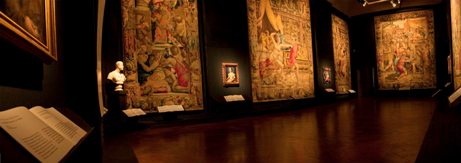
I’ve been visiting the cradle of the Renaissance regularly for 25 years and for the most part come away relieved and contented that nothing ever changes. The “chiuso” signs are an irritant which you learn to work around. In recent years the city’s relevant authorities have bowed slightly to market forces by opening certain cloisters or cemeteries on alternate Sundays. But this was a different level of commercial imperative.
I arrived from the Pisa airport at Friday lunchtime. The air in the Arno valley was crisp, cold and inimical to mass tourism. This is very much the low season for Florence. But the tall sturdy rooms on the first floor of the Palazzo Strozzi had already had a through-put of 1600 people that morning, among the last of the 140,000 visitors who would eventually clock through between last September and last Sunday.
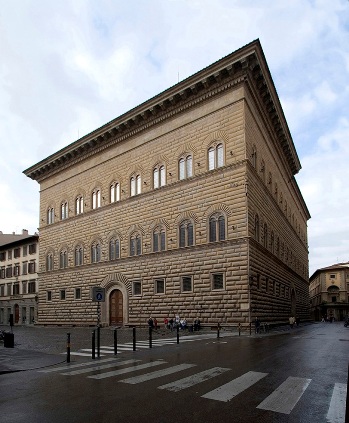 Such was the demand for tickets that they were keeping their doors open till 11pm on the final weekend. Blockbuster shows in the UK have been expanding their hours of access for years. It's different in Florence. While it may be the crucible of modern civilisation, the city has long shucked off its reputation for discovery and innovation. Its conservatism is one reason for the historical affinity with the English. You sometimes wonder whether the window displays in Via Tornabuoni, where the haute couture outlets are gathered, change any more than the bristling facade of the Palazzo Strozzi itself (pictured above), the street’s Quattrocento bruiser of a building recognisable by its signature vast rustic bricks.
Such was the demand for tickets that they were keeping their doors open till 11pm on the final weekend. Blockbuster shows in the UK have been expanding their hours of access for years. It's different in Florence. While it may be the crucible of modern civilisation, the city has long shucked off its reputation for discovery and innovation. Its conservatism is one reason for the historical affinity with the English. You sometimes wonder whether the window displays in Via Tornabuoni, where the haute couture outlets are gathered, change any more than the bristling facade of the Palazzo Strozzi itself (pictured above), the street’s Quattrocento bruiser of a building recognisable by its signature vast rustic bricks.
I somehow doubt whether the Palazzo Vecchio will need to take the same emergency measures for the show currently running in its own temporary exhibition space. For the Love of God is advertised in posters all over the city with images of a skull plastered in diamonds. Yes, yards away from the Galleria degli Uffizi, Damien Hirst has completed his journey to the bridge of the mothership: he is on display for five months in the very citadel of the Florentine Renaissance. This is just a personal stance, but Ammannati’s wild horses pulling the chariot of Neptune outside in the Piazza della Signoria couldn’t have dragged me over the threshold.
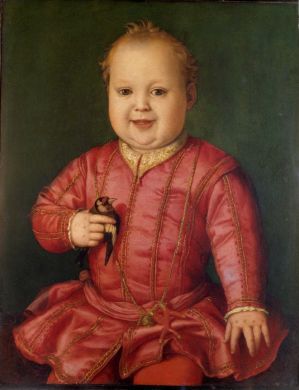 Meanwhile, over at the Palazzo Strozzi, the meddling with tradition can be attributed to James Bradburne, the Fondazione’s Canadian director general for the past four years. Innovatively for an Italian museum, the policy for both display and publication is carefully targeted to include younger visitors. Under the more child-friendly Bronzino works – the Uffizi's Portrait of Giovanni, son of Cosimo I de’ Medici , 1545, for example (pictured left) – were poems in Italian and English designed to set off questions in young minds. The only children I saw looking hideously bored all weekend were two little Americans being dragged round the Palazzo Vecchio by quixotic parents, who had hired a guide. Bronzino’s frescoed chapel for Eleonora of Toledo didn’t do it for them.
Meanwhile, over at the Palazzo Strozzi, the meddling with tradition can be attributed to James Bradburne, the Fondazione’s Canadian director general for the past four years. Innovatively for an Italian museum, the policy for both display and publication is carefully targeted to include younger visitors. Under the more child-friendly Bronzino works – the Uffizi's Portrait of Giovanni, son of Cosimo I de’ Medici , 1545, for example (pictured left) – were poems in Italian and English designed to set off questions in young minds. The only children I saw looking hideously bored all weekend were two little Americans being dragged round the Palazzo Vecchio by quixotic parents, who had hired a guide. Bronzino’s frescoed chapel for Eleonora of Toledo didn’t do it for them.
The Uffizi could certainly look and learn from the Palazzo Strozzi's sleek and inclusive style of presentation. In what is surely among the five most important art galleries in the world, a detailed explication of the Pollaiolo brothers' importance has been mounted on a bilingual display board. The English translation is an absolute dog’s dinner which the museum could easily have run past a fluent speaker before letting it out into the public domain.
I’ve been racking my brains and can’t think of a coherent argument to suggest that, in purely statistical terms, this hasn’t been the greatest exhibition of a Florentine master in living memory. There is no other prolific Renaissance painter so many of whose works have been gathered in one place, or even could be. The only other native artists whose finest works remain predominantly in Florence are Ghirlandaio and, of course, Brunelleschi. But one worked mostly in fresco and the other in pietra serena: Bronzino's oils on wood are rather more portable. Anyone who regrets missing the exhibition is encouraged to buy the ravishing and extremely thorough catalogue.
“No one can claim that Bronzino was unheard of,” says Antonio Natali, the director of the Uffizi who co-curated the exhibition with the leading authority on Bronzino, Carlo Falciani. “But then neither was he one of those artists whose names are guaranteed to draw the crowds. In addition to the knowledge and educational experience offered to visitors, the fact that they turned out in such vast numbers (particularly at this time of year) shows that the exhibition-goer, a naturally inquisitive type, is ready to look beyond Botticelli, Leonardo, Van Gogh, the Impressionists and other ‘popular’ crowd-pullers.” (The Palazzo Strozzi has a Botticelli-themed show coming in November entitled Money and Beauty: Bankers, Botticelli and the Bonfire of Vanities.)
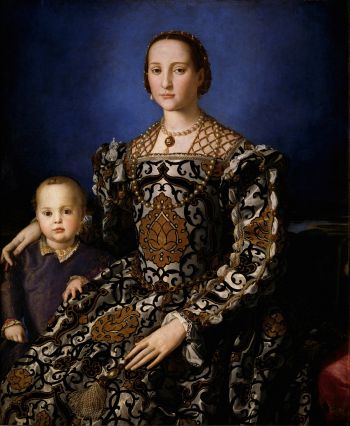 Before going in on the Friday afternoon, I met Natali in the courtyard of the Palazzo Strozzi and asked him how many Bronzinos from the Uffizi I could hope to find in there. The famous museum has quite a stock of the painter’s portraits of the Duke Cosimo de’ Medici and his family (pictured right, Eleonora of Toledo with Her Son Giovanni, 1545), plus many other Florentine nabobs. I was expecting him to say something like a dozen.
Before going in on the Friday afternoon, I met Natali in the courtyard of the Palazzo Strozzi and asked him how many Bronzinos from the Uffizi I could hope to find in there. The famous museum has quite a stock of the painter’s portraits of the Duke Cosimo de’ Medici and his family (pictured right, Eleonora of Toledo with Her Son Giovanni, 1545), plus many other Florentine nabobs. I was expecting him to say something like a dozen.
“Ci sono venticinque,” he said. The twenty-five Bronzinos from the Uffizi were cleverly used to leverage loans from the owners of most other Bronzinos in the world. “He’s the reason why this exhibition happened,” James Bradburne told me. They all stepped up, from the Art Gallery of New South Wales in Sydney to the National Gallery of Canada in Ottawa. From this country, the Queen loaned her slightly dowdy Bronzino. A private owner in England stumped up his St Cosmas, not long ago identified by Philippe Costamagna as a Bronzino.
The show was arranged on thematic lines. It started with the artist's apprenticeship to Pontormo. Being a longterm Pontormo obsessive, I could have happily stayed in the first two rooms savouring a rare chance to see in close proximity the four tondi of the evangelists, removed from their home just over the Ponte Vecchio in Santa Felicità. Normally, they are hung high and slanted in the spandrels of the Capponi chapel and peer down on Pontormo’s intoxicating Mannerist masterwork, The Deposition. Scholars have never been able to ascertain which of the four was done by the sole hand of Bronzino, as reported by Vasari, and they have been reattributed several times.
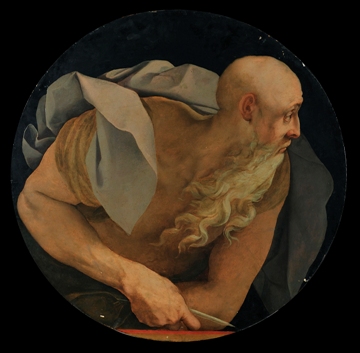 With apologies for the most unacademic form of punditry, it always seems to me that, when it comes to splitting two artists more closely entwined than perhaps any others in Vasari’s Lives, the eyes have it. Why? At half past 10 on a Saturday night I had uninterrupted access with no one else around to lean in close and pick out the wisps of white beard in St John the Evangelist, 1525-28 (pictured left), and the highly Pontormesque look of sorrow and alarm embedded in his eyes. (Admittedly, no one’s ever disputed that this one’s a Pontormo.) As an apprentice Bronzino may of course have been more inclined to paint in his master’s style, but these tondi hint that even as a young man he saw humanity looking back at him in a fundamentally different way. Even if Vasari’s pen portrait of Pontormo as a neurotic eccentric is to be taken with the usual pinch of salt, the evidence here is that Bronzino engages with his world with far more solidity and certainty. In the glistening dark eyes of the Medici portraits gathered here there is a clarity and directness that suggest a much more measured temperament in the pupil than the master. Not that I have a clue which of the evangelists is by Bronzino of course. It’s fun trying to guess, though.
With apologies for the most unacademic form of punditry, it always seems to me that, when it comes to splitting two artists more closely entwined than perhaps any others in Vasari’s Lives, the eyes have it. Why? At half past 10 on a Saturday night I had uninterrupted access with no one else around to lean in close and pick out the wisps of white beard in St John the Evangelist, 1525-28 (pictured left), and the highly Pontormesque look of sorrow and alarm embedded in his eyes. (Admittedly, no one’s ever disputed that this one’s a Pontormo.) As an apprentice Bronzino may of course have been more inclined to paint in his master’s style, but these tondi hint that even as a young man he saw humanity looking back at him in a fundamentally different way. Even if Vasari’s pen portrait of Pontormo as a neurotic eccentric is to be taken with the usual pinch of salt, the evidence here is that Bronzino engages with his world with far more solidity and certainty. In the glistening dark eyes of the Medici portraits gathered here there is a clarity and directness that suggest a much more measured temperament in the pupil than the master. Not that I have a clue which of the evangelists is by Bronzino of course. It’s fun trying to guess, though.
The room with the headiest intellectual flavour highlighted Bronzino the poet and allegorist (pictured below). It included two significant and complementary works:Venus, Cupid and Jealousy from Budapest and, from Rome, the Galleria Colonna’s Venus, Cupid and a Satyr. I must confess to a vicarious twinge of embarrassment to see a note alongside a small black-and-white illustration referring to An Allegory with Venus and Cupid. Like Macavity, the National Gallery’s iconic Bronzino was not there. (Nor for the record was the National’s Portrait of a Young Man, though as that is on loan from a private collection a sub-loan would have presumably been more complicated. Other Bronzino young men stayed put in the Frick and the Louvre.)
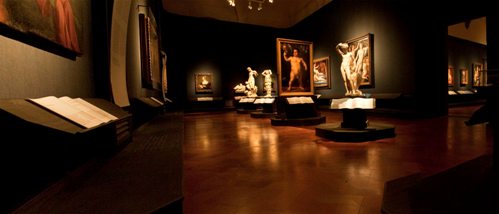
The absence of this enigmatic canvas seemed an astonishing omission. The curators will certainly have asked. Whatever the reason given, it’s hard to credit that the painting was not in good enough nick to travel. In order to secure the Budapest Venus and Cupid, the Uffizi was prepared to lend an entire exhibition to the Szépművészeti Múzeum. They even agreed to restore it before it travelled. (It did not consequently appear in this year's Treasures from Budapest show at the Royal Academy.)
You wonder if there will be repercussions. This November the National Gallery unveils the latest Leonardo blockbuster. Leonardo da Vinci: Painter at the Court of Milan is being billed as “the most complete display of Leonardo’s rare surviving paintings ever held”. According to the National Gallery’s website, exhibits will include La belle ferronière from the Louvre, the Madonna Litta from the Hermitage and Saint Jerome from the Vatican. There's no mention of the Annunciation and Adoration of the Magi, the two Leonardos in the Uffizi. These things will have been decided months or even years ago behind closed doors. But for ordinary gallery-goers who enjoyed the great wonders of an unrepeatable Bronzino show, it will be very interesting to see whether the Uffizi lends them or, like a Florentine museum of the old school, shuts the door and puts up a notice saying “Chiuso”.









![SEX MONEY RACE RELIGION [2016] by Gilbert and George. Installation shot of Gilbert & George 21ST CENTURY PICTURES Hayward Gallery](/sites/default/files/styles/thumbnail_125_x_125_/public/mastimages/Gilbert%20%26%20George_%2021ST%20CENTURY%20PICTURES.%20SEX%20MONEY%20RACE%20RELIGION%20%5B2016%5D.%20Photo_%20Mark%20Blower.%20Courtesy%20of%20the%20Gilbert%20%26%20George%20and%20the%20Hayward%20Gallery._0.jpg?itok=3oW-Y84i)





Add comment